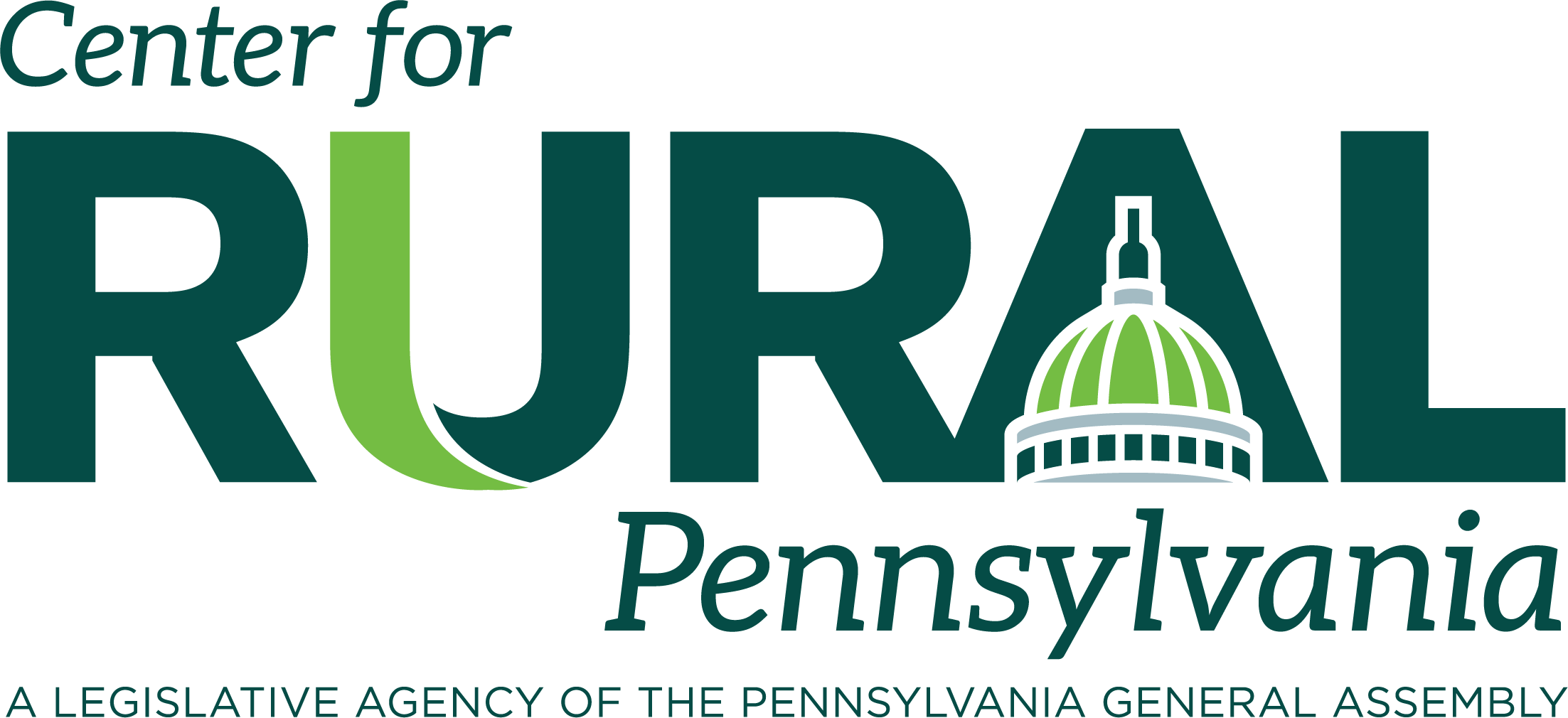Newsletters
- Home
- Publications
- Newsletter Archive
- Newsletter
January/February 2018
Inside This Issue:
- Center Announces 2018 Research Grant Projects
- Research Examines Wildlife Tourism on PA Public Lands
- Chairman's Message
- Center Board Welcomes New Member
- Rural Snapshot: Rural Pennsylvania's Working Poor
- Did You Know. . . This Old House
- Just the Facts: Local Breweries, Wineries & Distilleries
Center Announces 2018 Research Grant Projects
The Center for Rural Pennsylvania’s Board of Directors has awarded research grants to faculty at Pennsylvania State University and the University of Pittsburgh at Bradford as part of the Center’s 2018 Research Grant Program.
The research projects are set to begin in February and will focus on a wide range of issues to provide data and policy information to the Pennsylvania General Assembly.
The 2018 research projects will examine teacher supply and demand, the economic implications of foreign-born residents, senior community centers, oral health care for low-income children, broadband availability and access, the commercial sexual exploitation of children in rural and urban counties, and obesity rates of Pennsylvania school children.
“The Center’s Board of Directors, independent reviewers and Center staff are always mindful of the issues that need further examination,” said Senator Gene Yaw, Center board chairman. “From the grant review process, we recommend projects that will build on the Center’s base of information and rural Pennsylvania’s need for answers to important issues. As always, the board looks forward to sharing the results of this research with policy makers and our rural residents and communities.”
The 2018 research grant projects are summarized below.
Analysis of K-12 Teacher Demand and Supply in Pennsylvania
Dr. Ed Fuller of Pennsylvania State University will analyze trends in K-12 teacher supply and demand in rural and urban Pennsylvania public schools. The analysis will also examine the production of teachers by instructional area, such as elementary school generalist and secondary mathematics, and by rural and urban location and Intermediate Unit.
Economic Implications of Pennsylvania’s Foreign-Born Population
Dr. Brian Thiede of Pennsylvania State University will examine the contribution of foreign-born residents to economic activity in rural Pennsylvania. The research will estimate the foreign-born share of the workforce in rural Pennsylvania, develop a profile of this population’s socioeconomic characteristics, and compare the findings with urban and native-born populations. It will also analyze trends over time and identify policy implications.
Evaluation of Senior Community Centers in Rural and Urban Pennsylvania
Dr. Janet Ann Melnick of Pennsylvania State University €“ Worthington Scranton will analyze the challenges and opportunities that senior community centers face in providing service to rural and urban constituents. The research will identify innovative and successful models that senior centers are using to provide services to older adults in Pennsylvania as well as identify policy issues.
Oral Health Status of Low-income Children in Pennsylvania: A Rural/Urban Comparison
Lisa Davis of Pennsylvania State University will analyze data to identify potential gaps in oral health care for rural and urban low-income children and evaluate screening, preventive, and restorative services in private practices, schools, and public health settings. The research will identify policy considerations to increase the health status of Pennsylvania children.
Broadband Availability and Access in Rural Pennsylvania
Dr. Sascha D. Meinrath of Pennsylvania State University will conduct an extensive analysis and assessment of Pennsylvania’s broadband access. The research will provide a comprehensive array of new data for decision-makers by documenting the current availability of high-speed (25Mbps/3Mbps), fixed broadband services in rural Pennsylvania.
Incidence Rates and Risk Factors for Commercial Sexual Exploitation of Children (CSEC) in Rural and Urban Counties in Pennsylvania
Dr. Casey Pinto of Pennsylvania State University €“ Hershey will analyze Pennsylvania Children and Youth Services case management data from 2016-2017 to investigate CSEC in rural and urban settings. The research will provide evidence on the scope of CSEC in Pennsylvania and identify differences in risk factors among rural and urban victims.
Analysis of Obesity Rates for School Children in Pennsylvania
Dr. Shailendra Gajanan of the University of Pittsburgh at Bradford will tracks childhood obesity rates in the last 10 years, using data from rural and urban school districts in Pennsylvania. The research will identify socioeconomic and school district factors, such as PSSA scores, and free and reduced school lunch rates, that relate to changes in obesity rates within rural and urban districts.
Research Examines Wildlife Tourism on PA Public Lands
Pennsylvania residents and visitors sometimes use Pennsylvania State Game Lands for hiking, bird and wildlife watching, horseback riding, rock climbing, and mountain biking. While these secondary recreational uses are allowed, the main purposes of the State Game Lands (SGLs) are to manage habitat for wildlife and provide opportunities for lawful hunting and trapping.
At times, the non-consumptive use of SGLs has been a point of contention since some view non-hunting users on game lands as privileged, or sometimes, unwelcome guests.
To learn more about the extent to which the general public participates in non-consumptive, or wildlife tourism activities, on public land in Pennsylvania, Dr. Susan Ryan of California University of Pennsylvania conducted research by surveying hunters, non-hunters, and public policy stakeholders in 2016 and 2017.
The research examined the characteristics of wildlife tourists and their non-consumptive use of wildlife assets on Pennsylvania public lands, specifically focusing on Pennsylvania SGLs, which are administered by the Pennsylvania Game Commission.
The research also reviewed policy issues surrounding the access and use of Pennsylvania SGLs, and gathered input on public policies that govern these lands.
For the research, wildlife tourists were broadly defined as those who engage in non-consumptive or non-lethal wildlife activities for leisure purposes.
Data from the surveys were summarized to present a profile of current wildlife tourists and Pennsylvania’s available wildlife tourism product. It also summarized findings on policy issues related to permits and land use access for non-hunters and non-hunting activities.
Based on the survey results, the research provided several policy considerations as follows:
- Allow the Pennsylvania Game Commission to focus on science-based land and wildlife management;
- Encourage greater communication between tourism stakeholders and wildlife stakeholders through the Pennsylvania Travel and Tourism Partnership or another suitable outlet;
- Present simplified, visible, harmonious land use guidelines;
- Increase fines for abusive users;
- Implement an information campaign on the funding reality of Pennsylvania SGLs;
- Implement selective secondary-user, activities-based and voluntary, donation-based permitting;
- Implement secondary permitting on those SGLs that are used more often by secondary users, typically closer to urban centers;
- Increase permit fees for non-resident hunters; and
- Conduct a hunting tourism study to better understand its economic impacts.
For a copy of the research report, Wildlife Tourism on Pennsylvania Public Lands, visit the Center’s website at www.rural.palegislature.us.
Chairman's Message
Happy New Year and thank you for your support of the Center for Rural Pennsylvania in 2017 and for the year ahead. These coming months will be busy at the Center for Rural Pennsylvania as we start a new year of research projects and prepare to begin the next round of research for the Center’s 2019 Research Grant Program.
As detailed on Pages 1 and 3, this year’s round of funded projects is quite varied. The projects illustrate the diversity of issues and opportunities rural Pennsylvania communities are facing in 2018 and beyond. They also hold considerable potential to provide important information and policy considerations to the Pennsylvania General Assembly. And, as we have seen from prior research, the results prove useful for state and federal agencies, local governments, and even nonprofit organizations throughout the commonwealth.
As our researchers from our partnering universities begin their projects, draft final reports from the 2017 grant cycle are beginning to filter into the Center’s office. Staff reviews them for content and contract compliance, and, once assured of their thoroughness and accuracy, prepares them for board review and acceptance, and then for final publication. Highlights of a recently released report on wildlife tourism on Pennsylvania public lands are included in this issue on Pages 1 and 6.
Another layer of activity taking place over the next few months is the identification of potential research topics for the Center’s 2019 research grant cycle. At our first board meeting of every year, board members and staff bring potential research ideas to the table for review. The ideas are based on the knowledge and expertise of each board member, as each knows of the many issues and opportunities that rural communities are or may be addressing in the coming years.
We’re especially pleased to welcome Darrin Youker, of the Pennsylvania Farm Bureau, to the Center’s Board of Directors. Mr. Youker’s knowledge of Pennsylvania agriculture and our farming communities will certainly bring great insight to the board’s decision-making process.
After the ideas for the next research round have been reviewed, and the board approves the targeted research topics, the Center will prepare and issue its formal 2019 Request for Proposals. That’s when the next cycle begins and the work continues once again.
As the year progresses, we will continue to share the results of our research and database analyses on rural Pennsylvania with you. Thanks again for your support, and best wishes for a healthy New Year.
Senator Gene YawCenter Board Welcomes New Member
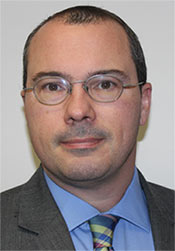 At its December meeting, the Center for Rural Pennsylvania’s Board of Directors welcomed Darrin Youker to the board.
At its December meeting, the Center for Rural Pennsylvania’s Board of Directors welcomed Darrin Youker to the board.
Mr. Youker was appointed to the board by Gov. Tom Wolf. He is the Director of State Government Affairs for the Pennsylvania Farm Bureau, and previously served as the Farm Bureau’s Director of Member Communication.
Prior to joining the Farm Bureau, Mr. Youker worked for more than a dozen years as a daily newspaper reporter for publications in New York and Pennsylvania.
He received his degree from the State University of New York at Fredonia.
Rural Snapshot: Rural Pennsylvania's Working Poor
For this analysis, the Center for Rural Pennsylvania, using a modified definition from the U.S. Bureau of Labor Statistics, defined the rural working poor as: non-institutionalized individuals age 18 years old and older who spent at least 27 weeks in the labor force during the preceding 12 months and whose household income was below the poverty level.
In 2016, the Census Bureau considered a two-person household with an income below $15,569 to be in poverty.
The data sources for this Snapshot are the 2012 and 2016 American Community Survey, 1-year average, Public Use Microdata Sample, U.S. Census Bureau.
The rural working poor make up about 5 percent of the total rural Pennsylvania workforce.
Rural Working Poor by Gender, 2016

Rural Working Poor by Race, 2016
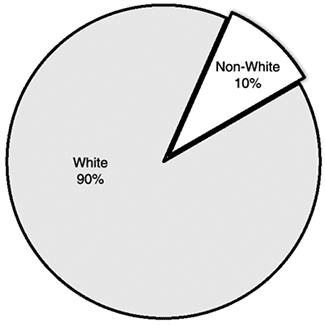
Rural Working Poor by Age Cohort, 2016

Top Three Industries Employing the Rural Working Poor, 2016
- 22 % Restaurant, Hotel, and Entertainment
- 16% Retail Trade
- 11% Health Care
Number of Rural Working Poor, 2012 to 2016
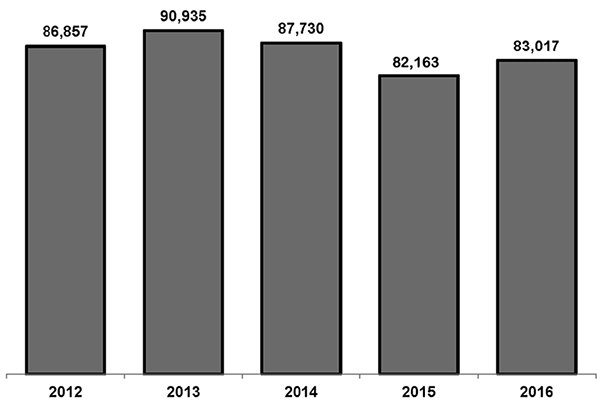
Rural Working Poor by Number of Hours Worked per Week, 2016
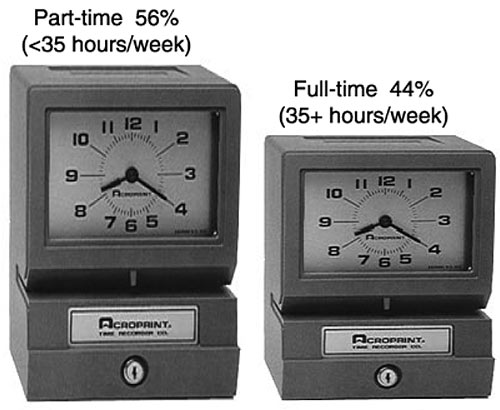
- 13 percent of rural working poor households do not have a vehicle.
- 14 percent of rural working poor households do not have home internet access.
- 16 percent of rural working poor live alone.
- 47 percent of working poor households have children under 18 years old.
Highest Level of Educational Attainment Among the Rural Working Poor, 2016
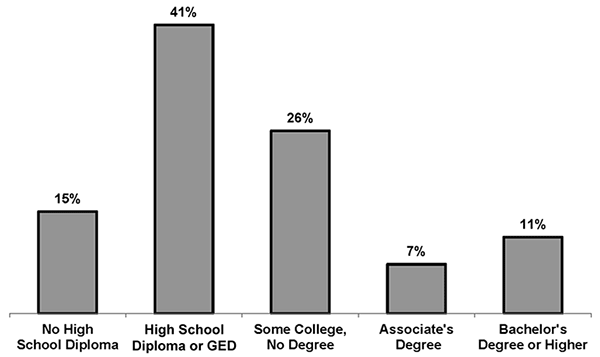
Did You Know. . . This Old House
428,712 Number of occupied housing units in rural Pennsylvania (26 percent) that were built before 1940. In urban Pennsylvania, 844,103 (25 percent) of all occupied housing units were built before 1940.
71 Percent of pre-1940 rural homes that are owner-occupied (61 percent for urban homes).
6.7 Average number of rooms in pre-1940 rural homes. Among urban pre-1940 homes, the average is 6.2.
77 Percent of pre-1940 rural homes that are detached single family homes. 10 percent are row homes or duplexes and 13 percent are a mix of apartment-type buildings. Among urban pre-1940 homes, 40 percent are detached single family homes, 38 percent are row homes/duplexes, and 22 percent are a mix of apartment-type buildings.
$90,000 Median value of a pre-1940 rural home. The urban median is $130,000.
$712 Median monthly gross rent for pre-1940 rural rental units. $904 is the median monthly gross rent for urban rental units.
14,826,700 Number of pre-1940 homes nationwide (13 percent). States with the highest percentages of pre-1940 homes: Massachusetts, New York, and Rhode Island, each with more than 29 percent. Pennsylvania comes in at number 5, with 26 percent.
Source: 2015 American Community Survey, Public Use Microdata Sample (ACS-PUMS).
Just the Facts: Local Breweries, Wineries & Distilleries
Pennsylvania, like the rest of the nation, is in the midst of a local beer, wine, and spirit growth spurt. According to licensing date from the Pennsylvania Liquor Control Board (PLCB), from 2014 to 2017, the number of brewery pubs increased 46 percent, the number of limited wineries increased 37 percent, and the number of limited distilleries increased 275 percent. This increase is occurring in both rural and urban Pennsylvania.
Generally speaking, licensed brewery pubs are authorized to sell malt or brewed beverages produced and owned by the brewery. The brewery pub must brew at least 250 barrels per year. Licensed limited wineries can sell the alcoholic ciders, wines and wine coolers they produce as long as they do not to exceed 200,000 gallons per year. Limited distilleries are those that produce not more than 100,000 gallons of distilled liquor per year.
According to PLCB data, as of December 2017, there were 20 brewery pubs in rural Pennsylvania and 66 in urban Pennsylvania. The three counties with the highest number of brewery pubs were Lancaster, York, and Chester, each with more than seven.
As of December 2017, there were 139 limited wineries in rural Pennsylvania and 174 in urban Pennsylvania. According to the licensing data, 22 limited wineries were missing location data. Allegheny, Berks, and York counties had the highest number of limited wineries, each with more than 15.
There were 24 limited distilleries in rural Pennsylvania and 51 in urban Pennsylvania as of December 2017. Allegheny, Bucks, and Philadelphia counties had the highest number of limited distilleries, each with more than four.
National data from the Brewers Association, a trade association for small and independent craft brewers, show that, in 2016, there were 1,916 brew pubs in the U.S. From 2012 to 2016, the number of brew pubs increased 63 percent.
Data from the Wine Institute, a trade association of wine producers, indicate there were 11,496 wineries of all sizes in the U.S. in 2016. From 2012 to 2016, the number of wineries increased 31 percent.
And, according to the American Craft Spirits Association, a trade group of distilleries, there were 1,439 distilleries of all sizes in the U.S. in 2016. The number of distilleries increased more than 200 percent from 2012 to 2016.
Cheers!
